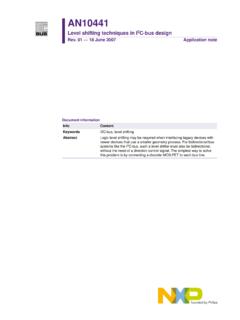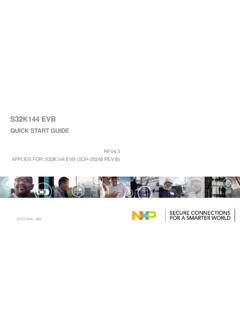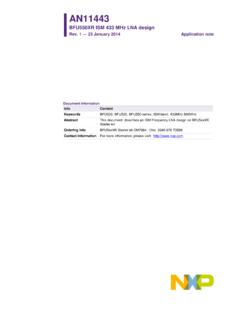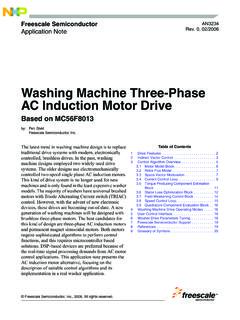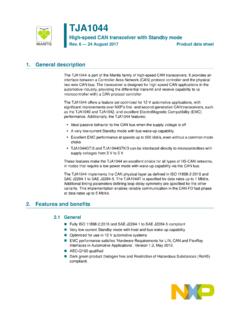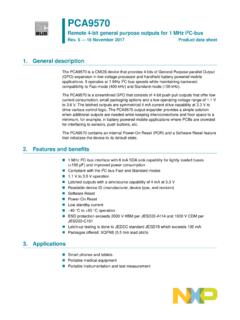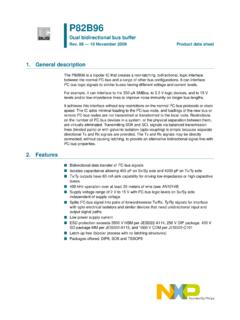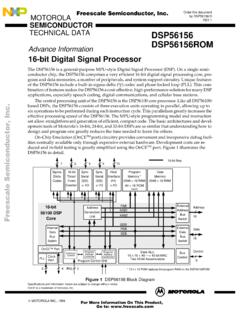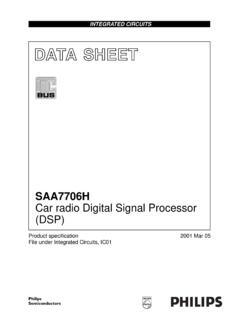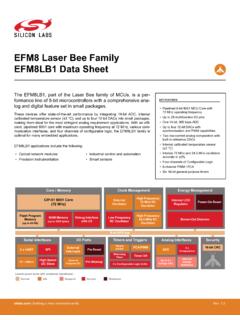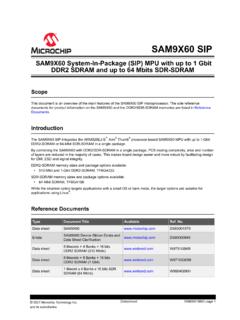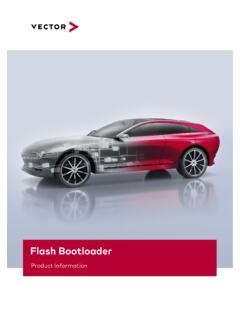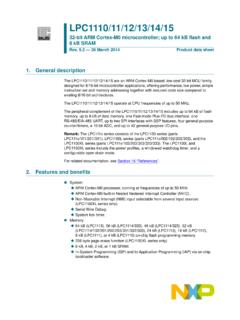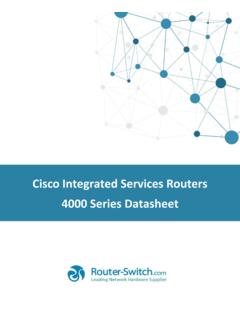Transcription of RT600 Product data sheet - NXP
1 1. General descriptionThe RT600 is a family of dual-core microcontrollers for embedded applications featuring an Arm Cortex-M33 CPU combined with a Cadence Xtensa HiFi4 advanced Audio Digital Signal Processor CPU. The Cortex-M33 includes two hardware coprocessors providing enhanced performance for an array of complex algorithms. The family offers a rich set of peripherals and very low power Arm Cortex-M33 is a next generation core based on the ARMv8-M architecture that offers system enhancements, such as ARM TrustZone security, single-cycle digital signal processing, and a tightly-coupled coprocessor interface, combined with low power consumption, enhanced debug features, and a high level of support block integration.
2 The ARM Cortex-M33 CPU employs a 3-stage instruction pipe and includes an internal prefetch unit that supports speculative branching. A hardware floating-point processor is integrated into the core. On the RT600 , the Cortex-M33 is augmented with two hardware coprocessors providing accelerated support for additional DSP algorithms and Cadence Xtensa HiFi 4 Audio DSP engine is a highly optimized audio processor designed especially for efficient execution of audio and voice codecs and pre- and post-processing modules. It supports four 32x32-bit MACs, some support for 72-bit accumulators, limited ability to support eight 32x16-bit MACs, and the ability to issue two 64-bit loads per cycle.
3 There is a floating point unit providing up to four single-precision IEEE floating point MACs per RT600 provides up to MB of on-chip SRAM (plus an additional 128 KB of tightly-coupled HiFi4 ram) and several high-bandwidth interfaces to access off-chip flash . The FlexSPI flash interface supports two channels and includes an 32 KB cache and an on-the-fly decryption engine. The RT600 is designed to allow the Cortex-M33 to operate at frequencies of up to 300 MHz and the HiFi4 DSP to operate at frequencies of up to 600 PeripheralsThe peripheral complement includes an FlexSPI flash interface with two channels, two SDIO/eMMC interfaces, a high-speed USB device/host with on-chip PHY, a 12-bit, 1 MSamples/sec ADC with temperature sensor, an analog comparator, AES256 and Hash engines with Physical Unclonable Function (PUF) key generation, a digital microphone RT600 Dual-core microcontroller with 32-bit Cortex -M33 and Xtensa HiFi4 Audio DSP CPUs; Up to MB SRAM; FlexSPI with cache and dynamic decryption.
4 High-speed USB device/host + Phy; 12-bit 1 Msamples/s ADC; Analog Comparator; Audio subsystems supporting up to 8 DMIC channels; SDIO/eMMC; AES/SHA/Crypto M33 coprocessor; PUF key generationRev. 30 December 2021 Product data sheetRT600 All information provided in this document is subject to legal disclaimers. NXP Semiconductors 2021. All rights data sheetRev. 30 December 2021 2 of 163 NXP SemiconductorsRT600 Dual-core microcontroller with 32-bit Cortex-M33 and Xtensa HiFi4 Audio DSP CPUsinterface supporting up to eight channels and Voice Activation Detect, one I3C interface, one high-speed SPI interface and seven configurable serial interfaces that can be configured as a USART, SPI, I2C or I2S bus interface, each including a FIFO.
5 When configured as USARTs the serial interfaces have the option to operate in deep-sleep mode using the 32 kHz oscillator or an external clock. There is a dedicated fractional baud rate generator for each of the serial peripherals include one advanced, 32-bit SCTimer/PWM module, five general purpose 32-bit timer/counters with PWM capability, a 24-bit, multiple-channel multi-rate timer, two windowed watchdog timers, a system tick timer with capture capability, and a Real-time clock module with independent power and a dedicated oscillator. A common OS Event Timer is provided for synchronized event generation and timestamping between the two are two general purpose DMA engines which can service most of the peripherals described in this section.
6 The two DMA engines may be assigned to different CPUs and/or one may be used for secure operations, the other for and hardware semaphores are provided to facilitate inter-core communication. A variety of oscillators and PLLs are available as clock sources throughout the Shared system SRAMThe entire system SRAM space of up to MB is divided into up to 30 separate partitions, which are accessible to both CPUs, both DMA engines, and all other AHB bus masters. The HiFi4 CPU accesses the RAM via a dedicated 256-bit interface. Cache (with single-cycle access) is provided on this interface to improve performance. All other masters, including the Cortex-M33 processor and the DMA engines, access RAM via the main 32-bit AHB bus.
7 These accesses are all single-cycle. Hardware interface modules arbitrate access to each RAM partition between the HiFi4 and the AHB software control, each of the 30 individual SRAM partitions can be used exclusively as code or as data , dedicated either CPU, or shared among the various masters. Each partition can be independently placed in a low-power retention mode or powered off addition to the shared SRAM, a total of 128 KB (64 KB code, 64 KB data ) of local, Tightly-Coupled Memory (TCM) is provided for the exclusive use of the HiFi4 DSP processor. Access to this memory is Features and benefits Control processor core Arm Cortex-M33 processor, running at frequencies of up to 300 MHz.
8 Arm TrustZone. Arm Cortex-M33 built-in Memory Protection Unit (MPU) supporting eight regions Hardware Floating Point Unit (FPU). Arm Cortex-M33 built-in Nested Vectored Interrupt Controller (NVIC). Non-maskable Interrupt (NMI) information provided in this document is subject to legal disclaimers. NXP Semiconductors 2021. All rights data sheetRev. 30 December 2021 3 of 163 NXP SemiconductorsRT600 Dual-core microcontroller with 32-bit Cortex-M33 and Xtensa HiFi4 Audio DSP CPUs Two coprocessors for the Cortex-M33: a hardware accelerator for fixed and floating point DSP functions (PowerQuad) and a Crypto/FFT engine (Casper). The DSP coprocessor uses a bank of four dedicated 2 KB SRAMs.
9 The Crypto/FFT engine uses a bank of two 2 KB SRAMs that are also AHB accessible by the CPU and the DMA engine. Serial Wire Debug with eight break points, four watch points, and a debug timestamp counter. It includes Serial Wire Output (SWO) trace and ETM trace. Cortex-M33 System tick timer. DSP processor core: Cadence Xtensa HiFi4 Audio DSP processor, running at frequencies of up to 600 MHz. Hardware Floating Point Unit. Up to four single-precision IEEE floating point MACs per cycle. Serial Wire Debug (shared with Cortex-M33 Control Domain CPU). System tick timer. Triple I/O power: Three independent supplies powering different clusters of pins to permit interfacing directly to off-chip peripherals operating at different supply levels.
10 On-chip Memory: Up to MB of system SRAM accessible by both CPUs and all (dedicated and general purpose) DMA engines. 128 KB of local, Tightly-Coupled Memory dedicated to the DSP CPU. 96 KB (or more) of I & D cache for DSP accesses to shared system SRAM. Additional SRAMs for USB traffic (8 KB), Cortex-M33 coprocessors (4 x 2 KB), SDIO FIFOs (2 x 512 B dual-port), PUF secure key generation (2 KB), and FlexSPI cache (32 KB). 16 K bits of OTP fuses for factory and user configuration. Up to 256 KB ROM memory for factory-programmed drivers and APIs. System boot from SPI, I2C, UART, Octal/Quad SPI flash , HS USB or eMMC via on-chip bootloader software included in ROM.
